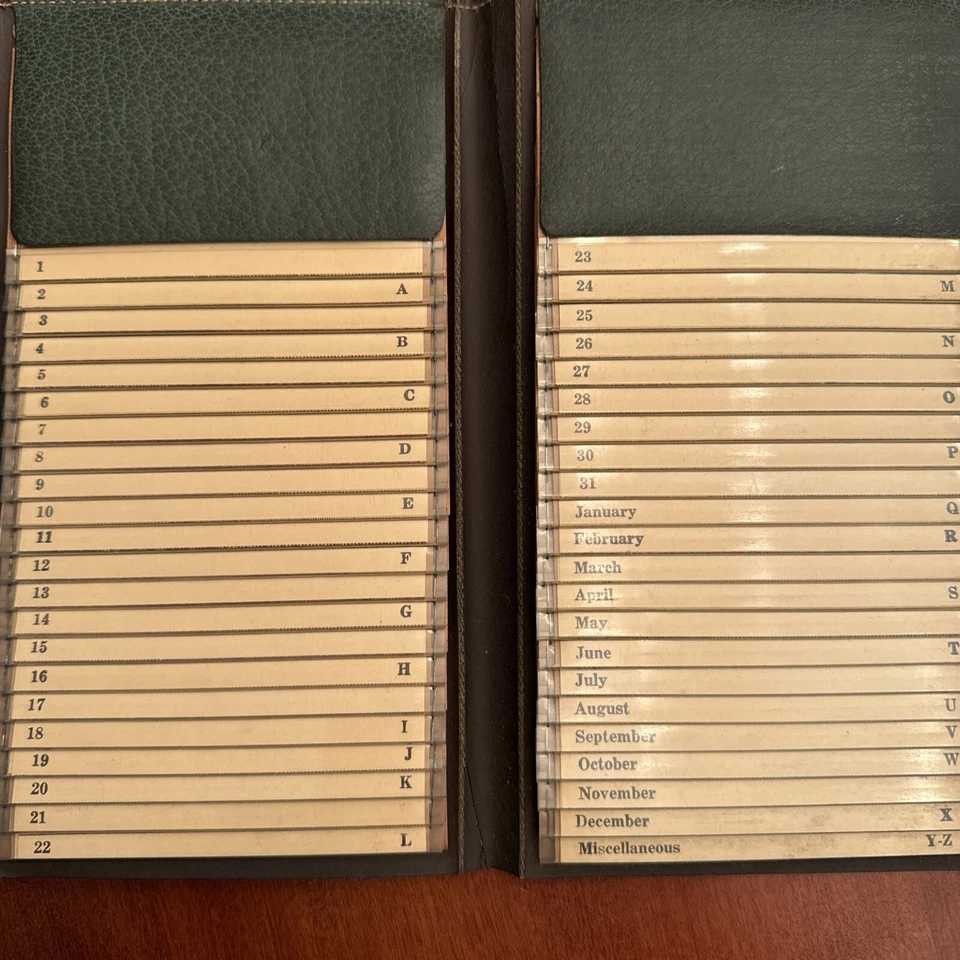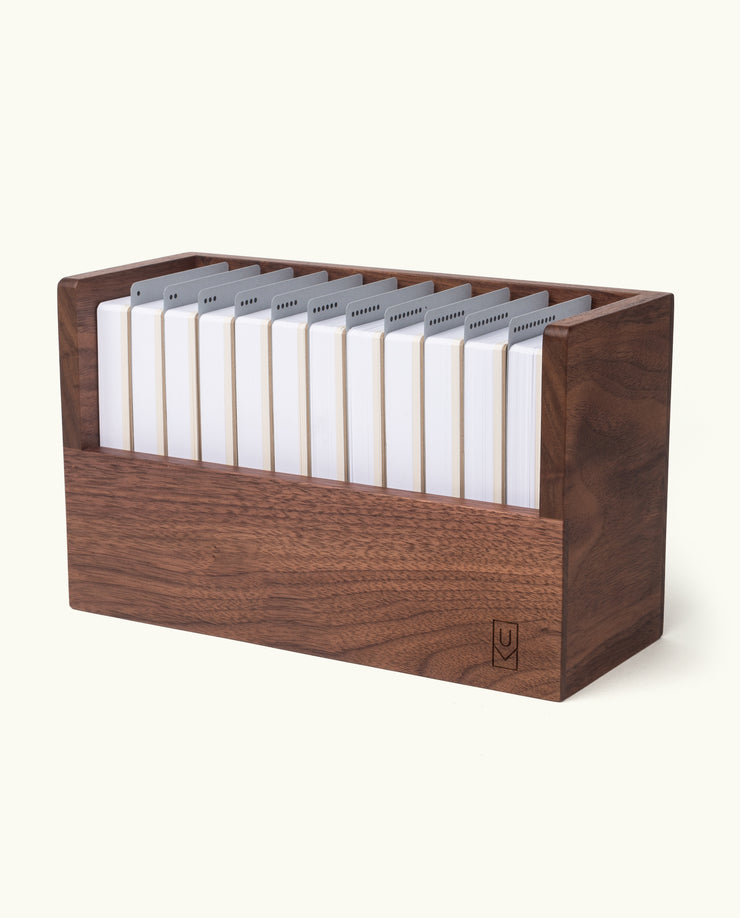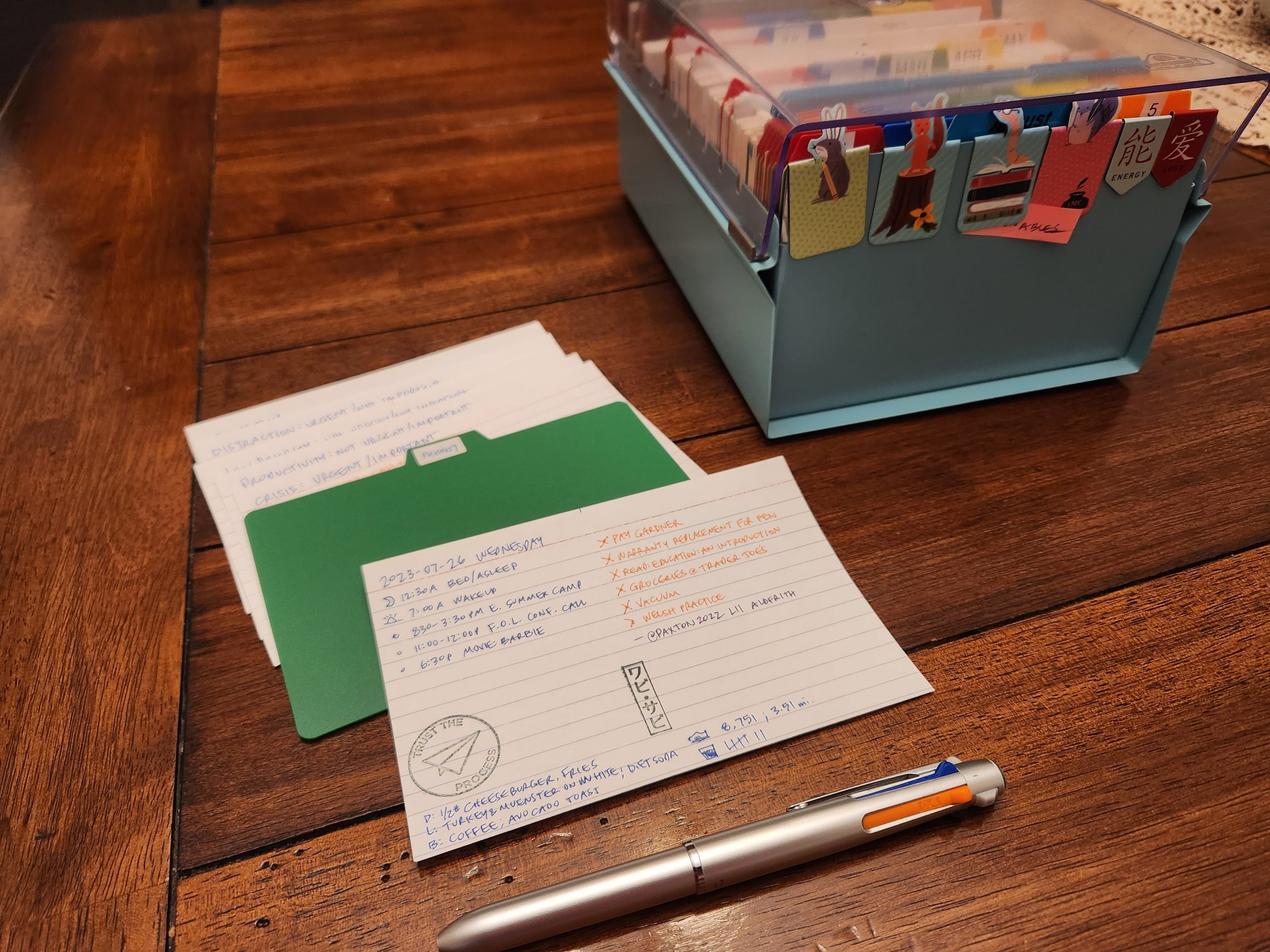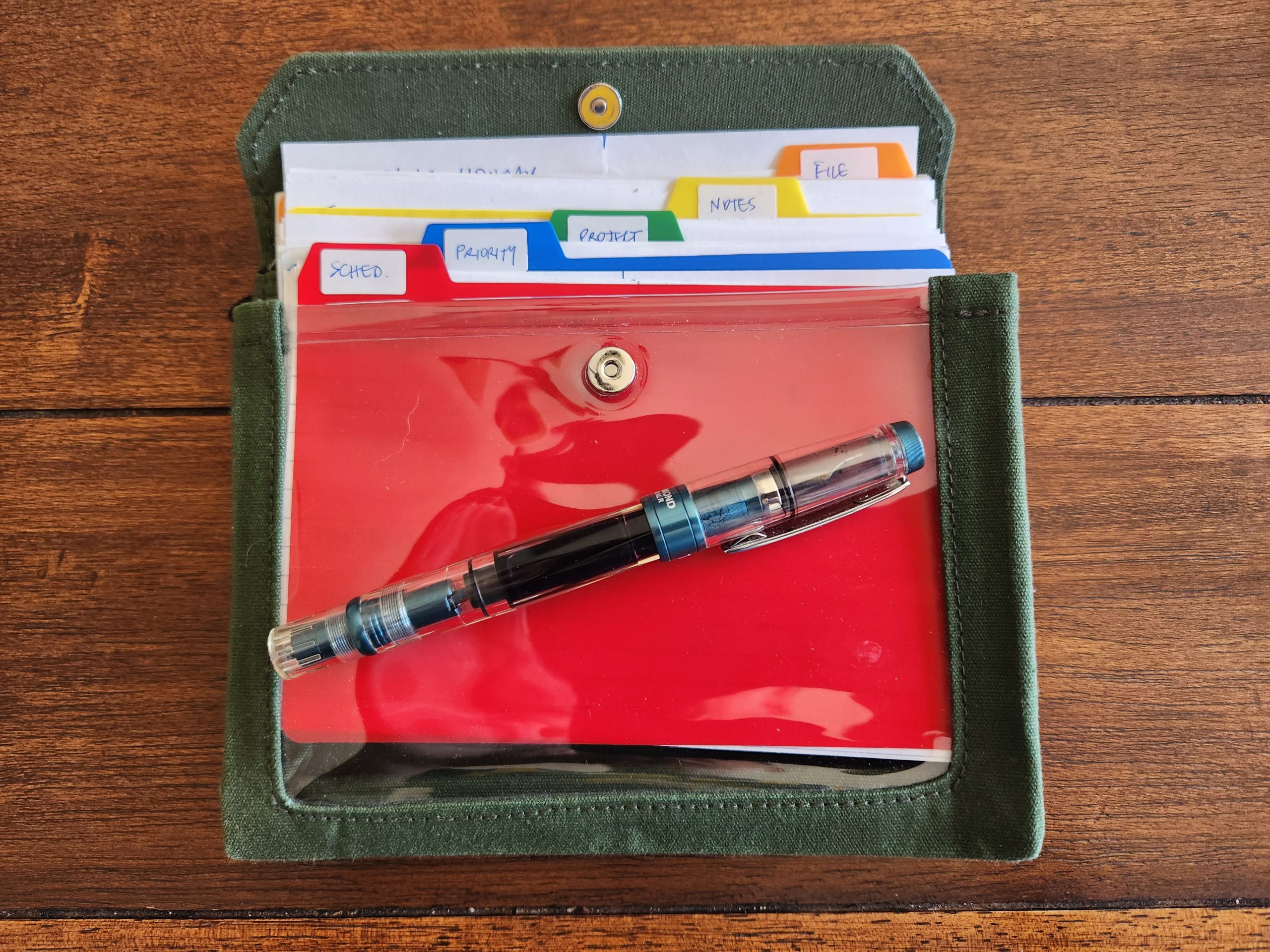https://www.instagram.com/p/DQWrYUPDsrv/?hl=en
Gloria Steinem was using a Memindex in 1960!
https://www.instagram.com/p/DQWrYUPDsrv/?hl=en
Gloria Steinem was using a Memindex in 1960!
1930’s advertisement for the Memindex Jr.

The phrase "get things done" actually appears in this advertisement for the Memindex Jr. in 1930!
System, the Magazine of Business, volume XLII, Number 6(?), December 1922, p763 an advertisement for the Memindex
Here's my setup: Literature Notes go in the literature folder. Daily Notes serve as fleeting notes. Project-related Notes are organized in their specific project folders within a larger "Projects" folder.
inspired by, but definitely not take from as not in evidence
Many people have "daily notes" and "project notes" in what they consider to be their zettelkasten workflow. These can be thought of as subcategories of reference notes (aka literature notes, bibliographic notes). The references in these cases are simply different sorts of material than one would traditionally include in this category. Instead of indexing the ideas within a book or journal article, you're indexing what happened to you on a particular day (daily notes) or indexing ideas or progress on a particular project (project notes). Because they're different enough in type and form, you might keep them in their own "departments" (aka folders) within your system just the same way that with enough material one might break out their reference notes to separate books from newspapers, journal articles, or lectures.
In general form and function they're all broadly serving the same functionality and acting as a ratchet and pawl on the information that is being collected. They capture context; they serve as reminder. The fact that some may be used less or referred to less frequently doesn't make them necessarily less important
https://www.ebay.com/itm/156425307066
Remington Rand leather portable card index notebook case with slots for a variety of functionalities: - 1-31 for days of month - Alphabetic categorization A-Z - Months (Jan-Dec) - Miscellaneous

https://www.ebay.com/itm/156407303710
Pocket note card portion of the Memindex System
According to each of the printed cards, the system was patented on 1904-12-06.



The daily cards and journal entries are obviously indexed by chronological date and then within tabbed sections by month and year.
The rest of the other cards with notes are given individual (decimal) numbers and and then are put into numerical order. These numbered cards are then indexed by putting related subject/topic/category words from them onto a separate index card which cross references either a dated card or the numbered card to which it corresponds. These index cards with topical words/phrases are then filed alphabetically into a tabbed alphabetical section (A-Z).
As an example with the card in this post, if I wanted to remember all the books I buy from Octavia's Bookshelf, then I'd create a card titled "Octavia's Bookshelf" and list the title along with the date 2024-08-13 and file it alphabetically within the "O" tab section of the index. Obviously this might be more useful if I had more extensive notes about the book or its purchase on the 2024-08-13 card. I did create a short journal card entry about the bookstore on 08-13 because it was the first time I visited the bookstore in it's new location and decor, so there are some scant notes about my impressions of that which are cross-indexed to that Octavia's Bookshelf card. Thus my Octavia's Bookshelf card has an entry with "The Book Title, 2024-08-13 (J)(R)" where the '(J)' indicates there's a separate journal entry for that day and the '(R)' indicates there's also a receipt filed next to that day's card.
I also created an "Author Card" with the author of the book's name, the title, publication date, etc. I included the purchase date and the reason why I was interested in the book. I'll use that same card to write notes on that particular book as I read it. These author cards are filed in a separate A-Z tabbed 'Bibliography' section for easily finding them as well. (I suppose I could just put them into the primary A-Z index, but I prefer having all the authors/books (I have thousands) in the same section.)
I also have a rolodex section of people filed alphabetically, so I can easily look up Steve and Sonia separately and see what I might have gotten them on prior birthdays as well as notes about potential future gift ideas. I had tickler cards with their names on them filed in early August and now that they're in my to do list, I've moved those cards to August 2025, ready for next year's reminder. Compared to a typical Future Log I don't do nearly as much writing and rewriting when migrating. I just migrate a card forward until it's done or I don't need it anymore.
If you've used a library card index before, the general idea is roughly the same, you're just cross-indexing more than books by title, author and subject. You can index by day, idea, project, or any other thing you like. My card index cabinet is really just a large personal database made out of paper and metal.
The secret isn't to index everything—just the things you either want to remember or know you'll want to look up later and use/re-use.
Howard L. Wilson, creator of the Memindex system starting 1903 and in wide use through the 1950s, would be proud that a modern variation of his system is still living in analog form. While it doesn't provide the bench depth of options of materials and sizes, the system is compact, modern, and just as simple as the original. The handcrafted archive boxes now bring the system up to par with its predecessor with grace and an elegant minimalistic esthetic.
Perhaps in a few years we might see something akin to Yawman & Erbe or Shaw-Walker's 16 drawer filing cabinets for long term storage of multiple years?
Ugmonk released a limited edition of 100 archive boxes for their Analog productivity cards today at 7AM (Pacific) for $229.00 (including 12 card packs and a metal divider). It sold out within two and a half hours.
With the inclusion of this archive box it makes the system much more like the original Memindex system.
https://ugmonk.com/products/analog-archive-box-walnut?variant=43942761562262

Chronological registers or directories may beRegisters used for a variety of purposes in almost everyoffice, not only as future reminders^ but alsoas records of past events.
Broadly this sounds like an indexed corporate diary of sorts, but his use of future reminders (or ticklers in the footnote) certainly points to the use of index cards in a Memindex-like fashion.
Keep in mind that he's writing in Britain and the Memindex from 1903 was a US-based product, though similar ideas may have been used at the time across the pond.
https://www.ebay.com/itm/276403515343 <br /> archived copy
In 1984, Memindex was selling monthly planning calendars (pocket notebook size with spiral binding and a case) rather than their older small index card sized formats. Their calendar format looks eerily like what Day-Timer, a division of ACCO Brands, has been selling since at least the early 1990s.
This goes down to even the "cut here" triangles in the lower right corners of pages to help bookmark the current page.
1984 spiral bound pocket planner<br /> Memindex, 149 Carter Street, Rochester, NY 14601 Copyright 1977, so presumably they'd been making a version of this pocket calendar/planner since then.
So I take down notes, and then what? Jackhansonc November 8 in The Zettelkasten Method Flag Hi, A few years ago, I started to take daily note and take a lot, but at the end of a day, I have difficulty on how to deal with those notes. The major problem is, I can't decide the size of a note derived from my daily note. Say, I take a note like "5 students have sent me the language test invoice regarding applying for an academic reward. In my understanding, this could be directly put into "Academic Reward" or "Things related to Academic Reward for Language Test". But if I do so, I feel guilty because it looks not even a bit like a Zettel systems. I heard a lot of so-called atomic notes, but I never really see a real-world, down-to-earth workflow of authentic zettel.
reply to Jackhansonc at https://forum.zettelkasten.de/discussion/2726/so-i-take-down-notes-and-then-what#latest
I'm not sure I understand the full context of your note and it's purpose. If I had to guess, it's closer to what I might consider a productivity note to be followed up on as part of a potential project. Personally, I keep things like this in a separate drawer (or what I would call a "department") of my zettelkasten which acts more like a Memindex (more details on my specific practice). These project and to-do related items are valuable, but I don't treat them with the same level of rigor and indexing that I do for cards with buildable ideas.
Notes from my reading, for my writing, knowledge building, etc. are the ones I keep in my primary zettelkasten department. These are the ones which are better indexed and more highly interlinked.
I know that some here do keep everything more closely integrated and to some extent mine really are are as well. I find that keeping some sort of mental separation about what specific tranches of notes are for can be helpful, and even placing them in separate drawers (or digital areas/folders) may be useful to some. As long as you can search for and find it when you need it, you can't go far wrong. In my case having a specific section for to do items and projects means I'm regularly culling through them, something which I might not be as prone to do in other portions of my collection.
Plan Your Work and Work Your Plan. <br /> —Memindex price list booklet circa 1913 https://www.ebay.com/itm/166293242710
Surely this was in use prior to this version...
A year of Bullet Journaling on Index Cards inspired by the Memindex Method
I'm just wrapping up a year of maintaining my bullet journal practice using index cards instead of the more popular notebook form factor. It's heavily inspired by the century+ old Memindex method.
AMA



https://boffosocko.com/2023/04/20/review-of-king-jim-a6-size-horizontal-flatty-works-case-5460/
Syndication Link: https://www.reddit.com/r/bulletjournal/comments/15av66m/a_year_of_bullet_journaling_on_index_cards/
Levenger sells a line of various "pocket briefcases" which include space for 3 x 5" index card "ticklers" which are similar in form to the old Memindex.
Thank you for your interest in our Corporate program. We offer bulk discounts on product for organizations that are looking to incorporate 3x5 Life into their company culture or would like to utilize our product as a way to stay 'top of mind' with their customers. We offer a co-branded solution to add your personal touch to the cards.
Much like its predecessors (Park Sherman Co.) 3x5 Life offers co-branded products to corporations.
Did Memindex do this sort of co-branding? I feel like I've seen something to indicate it.
Compare with other products in this category: - Analog (Jeff Sheldon productivity system) - Memindex - Bullet Journal - Frictionless Capture Cards - Pile of Index Cards

https://ugmonk.com/pages/analog
Jeff Sheldon describes how the Analog system works, generally following most of the outline of the Memindex method, but with some hints of the Bullet Journal method's notation.
https://www.kickstarter.com/projects/ugmonk/analog-the-simplest-productivity-system
Jeff Sheldon's Analog productivity system is a physical product consisting of a wooden tray, metal divider, 3 x 5" custom printed index cards (and refills), a felt carrier, and other accessories which functions as a minimalistic version of the old Memindex.
simonwoods 10:28 am I'm using the Analog system by Jeff Sheldon. It's like Memindex mixed with Patrick Rhone's Dash/Plus System.
comment at micro.camp https://help.micro.blog/chat/channel/6/micro-camp
https://www.etsy.com/listing/798326374/directory-telephone-address-book-zande
Zande was making the Phonedex in Sweden by some time in the 1960s.

https://www.ebay.com/itm/265844599407
The product information from the Phondex indicated that Memindex was established in 1902
Memindex Phondex Office Phone Number Organizer Styrene NOS
Memindex, Inc. of Rochester, NY manufactured a plastic "Phonedex" in the mid-20th century. It was made of Dow Chemical Styrene and sat underneath a standard rotary dial telephone and contained index cards with one's lists of phone numbers on them.

Brodart Full-Length Single Charging Tray<br /> Full- length charging tray with 1,000-card capacity<br /> Price: $96.32

See also: https://hypothes.is/a/ao89RMQmEe2zIvsu3lf6kw for a smaller version
Brodart Mini Single Charging Tray Mini single charging tray with 600-card capacity More Info Price: $76.76

This could be used for a modern day Memindex box for portrait oriented 3 x 5" index cards.
Trademark for Memindex
Ser. No. 511,916. WILSON MEMINDEX COMPANY, Rochester, N. Y. Filed Aug. 23, 1947.<br /> FOR LOOSE-LEAF DAILY MEMORANDUM CARD SYSTEM COMPRISING MEMORANDUM CARDS AND POCKET AND DESK CASES THEREFOR.<br /> Claims use since Aug. 1, 1903.
(p58, SEPTEMBER 7, 1948) (aside: interesting to note that Wurlitzer is on the same page!)
Memindex, Wilson Company, Rochester, N. Y. Loose - leaf daily memorandum card system . Serial No. 511,916, Sept. 7. Class 37.
Official Gazette of the United States Patent Office. Vol. 614. United States Patent Office, 1948.
https://www.google.com/books/edition/Collier_s/IDwa6nqexo8C?hl=en&gbpv=0
Memindex advertised in Collier's (Volume 34) in 1904.
General instructions for using a Memindex
HOW IT IS USED <br /> Things to be done today, jot on face card. Things to be done tomorrow or next Friday, jot on card for that day. Things to keep before you until done, jot on opposite front card. A matter for January 10th jot on a short card put under the band till you return to your desk, then file next to card for January 10th when it will come out and refresh your memory.
Things to be done when in New York or Chicago jot on card "N" or "C." The new address of Mr. Jones, under "J." Ideas on advertising jot on card tabbed "adv." Things for your clerk to do, on his card , etc., etc. Retire today's card tonight, carrying forward things not completed and put next card in the file in has proved that almost back of pocket case. The alphabet enables one to index all jottings for instant reference. This system is very comprehensive yet perfectly simple. You soon the learn to depend on it every hour of every day.
Within the general instructions in a 1904 Memindex advertisement (next to an ad for "Genuine Edison Incandescent Lamps") we see the general ideas of indexing things into the future and carrying undone tasks forward, just as is done in the bullet journal method.
Howard L. Wilson, Manufacturer, 45 State St., Rochester, N. Y.<br /> (next to an ad for "Genuine Edison Incandescent Lamps")(p.2 in a 2/3 page ad)
Carleton, Hubert, ed. St. Andrew’s Cross. Vol. 19. Brotherhood of St. Andrew., 1904.
Specific issue: Nov-Dec 1904 Vol. 19, No 2-3, Pittsburgh, PA
Howard L. Wilson, Mfr., 61 State St., Rochester, N.Y. (p.392)
Miller, Kempster B., William A. Colledge, Alfred S. Johnson, and Carl S. Dow, eds. Technical World Magazine. Chicago, IL: American School of Correspondence at Armour Institute of Technology, 1905. https://www.google.com/books/edition/Technical_World_Magazine/CgLOAAAAMAAJ?hl=en&gbpv=0
Specific issue: The Technical World, Volume II, No. 3, November 1904 Chicago
Hudson & Hudson are also supplying business housesthe rubber, and gives many odd and curious shapes. How- with “ Memindex, " the vest pocket card index, which makesever, it is somewhat difficult for us to describe these cards it impossible for any business appointment or transaction
Hudson & Hudson of Toledo, OH were one of the early distributors of Howard L. Wilson's Memindex system.
Geyers Stationer. “The Revolving Desk Tray.” Geyer’s Stationer: Devoted to the Interests of the Stationery, Fancy Goods and Notion Trades, November 10, 1904. vol. 38, issue 940, p25. https://www.google.com/books/edition/Geyer_s_Stationer/L507AQAAMAAJ?hl=en&gbpv=0.
2 3-4 x 4 3-4 inches in size, made of seal grain , real sealor Russia leather, in a thoro
Memindex dimensions mentioned in a 1904 advertisement<br /> cards: 2 3/4 x 4 1/2 inches<br /> case: 2 3/4 x 4 3/4 inches
mindex.THIS is the name Howard L. Wilson, of Rochester, N.Y.,hasgivenhisvestpocket cardsystem.Itisa
Geyers Stationer. “Memindex Advertisement.” Geyer’s Stationer: Devoted to the Interests of the Stationery, Fancy Goods and Notion Trades, September 15, 1904. https://www.google.com/books/edition/Geyer_s_Stationer/L507AQAAMAAJ?hl=en&gbpv=0
Howard L. Wilson of Rochester, NY named his vest pocket card index system the Memindex.
656,140 72/009,833 12/24/1957
https://www.uspto.gov/web/offices/com/sol/og/1998/week46/pattmex.htm
This would appear to indicate that the Trademark of the Wilson Memindex expired in 1998.
Compare with listing at https://www.google.com/books/edition/Index_of_Trademarks_Issued_from_the_Unit/YhBWAAAAMAAJ?hl=en&gbpv=0
H. W. ONSTEDMEMORANDUM FILE,APPLICATION FED MAR. 10, 1915,1,196,269. Patented Aug. 29, 1916,Y: NIIWax SavassasZ INVENTOR 7Zez-?ezz W. OZZzzsaeafuis ATTORNEYS
https://patentimages.storage.googleapis.com/9c/1b/c4/42ee9bd28aae7d/US1196269.pdf
https://patents.google.com/patent/US1196269A/en?assignee=memindex&oq=memindex
Patent for Memex, but not for the original system.
Poem from the inside back cover of a 1913 Memindex Catalog:
JUST JOT IT DOWN.
If you’re going to meet a man<br /> Jot it down<br /> If you’ve got a little plan<br /> Jot it down<br /> If you never can remember<br /> Your requirements for September<br /> ’Till October or November<br /> Jot ’em down.
If you’ve got a note to pay<br /> Jot it down<br /> If its due the first of May<br /> Jot it down<br /> If collections are so slow<br /> That to meet the note you know<br /> You must dun old Richard Roe<br /> Jot it down
If you have a happy thought<br /> Jot it down<br /> If there’s something to be bought<br /> Jot it down<br /> Whether duty calls or pleasure<br /> If you’re busy or at leisure<br /> It will help you beyond measure<br /> Jot it down
If there’re facts that you’d retain<br /> Jot ’em down<br /> If you’ve got to meet a train<br /> Jot it down<br /> If at work or only play<br /> If at home or far away<br /> In the night or in the day<br /> Jot it down
Plan Your Work and Work your Plan An Infallible Rule for Success
was there a prior source for this aphorism?
c.1913 Wilson Memindex Desk Organzier Catalog Price List Booklet Rolodex Prequel
In a 1913 catalog for the Wilson Memindex, the company suggested putting to do items and one's schedule on one side of the card and potentially keeping one's accounts or a diary on the reverse side.
Witness the unapologetic swagger of "FORGET WITH IMPUNITY" vs. its wimpy cousin Evernote's "Remember Everything".
—u/spanchor
Wilson Memindex Company (Rochester, N.Y.), 1922
The archives at Yale have Some trade catalogs of the Wilson Memindex Co. on file.
1930s Wilson Memindex Co Index Card Organizer Pre Rolodex Ad Price List Brochure
archived page: https://web.archive.org/web/20230310010450/https://www.ebay.com/itm/165910049390
Includes price lists

List of cards includes: - Dated tab cards for a year from any desired. - Blank tab cards for jottings arranged by subject. - These were sold in 1/2 or 1/3 cut formats - Pocket Alphabets for jottings arranged by letter. - Cash Account Cards [without tabs]. - Extra Record Cards for permanent memoranda. - Monthly Guides for quick reference to future dates. - Blank Guides for filing records by subject.. - Alphabet Guides for filing alphabetically.
Memindex sales brochures recommended the 3 x 5" cards (which had apparently been standardized by 1930 compared to the 5 1/2" width from earlier versions around 1906) because they could be used with other 3 x 5" index card systems.
In the 1930s Wilson Memindex Company sold more of their vest pocket sized 2 1/4 x 4 1/2" systems than 3 x 5" systems.
Some of the difference between the vest sized and regular sized systems choice was based on the size of the particular user's handwriting. It was recommended that those with larger handwriting use the larger cards.
By the 1930's at least the Memindex tag line "An Automatic Memory" was being used, which also gave an indication of the ubiquity of automatization of industrialized life.
The Memindex has proved its success in more than one hundred kinds of business. Highly recommended by men in executive positions, merchants, manufacturers, managers, .... etc.
Notice the gendering of users specifically as men here.


Features: - Sunday cards were sold separately and by my reading were full length tabs rather than 1/6 tabs like the other six days of the week - Lids were custom fit to the bases and needed to be ordered together - The Memindex Jr. held 400 cards versus the larger 9 inch standard trays which had space for 800 cards and block (presumably a block to hold them up or at an angle when partially empty).
The Memindex Jr., according to a price sheet in the 1930s, was used "extensively as an advertising gift".
The Memindex system had cards available in bundles of 100 that were labeled with the heading "Things to Keep in Sight".
1930s Wilson Memindex Junior Index Card Box Pre Rolodex Ad Price List Brochure
Note that the seller mistakenly lists it as a pre-rolodex!
Good photos including a list of supplies and prices:

A description of roughly how the Memindex system works:

Page archive: https://web.archive.org/web/20230310002530/https://www.ebay.com/itm/165910053313
Vintage Memindex Wilson Wood Box 1937-38 Diary Planner Date Keeper Ephemera
Includes particularly good image of the individual day cards:

Notice that the tabs are done as 1/6th as most of these systems were manufactured/sold with out including Sunday.
Memindex Wilson Wood Box 1945-47 Diary file Planner Vintage Secretary
Great photos including one of some of the individual cards.
 (Photo archived into note taking folder as well.)
(Photo archived into note taking folder as well.)
There's some interesting comparison to the ideas here and the long term state-of-the-art in information management, particularly in business and library settings which Bush wholly ignores.
Most fascinatingly Bush "coins" memex here, but prior art for the Memindex as a similar product in the office/business productivity space easily goes back to 1906 and was popular to and through at least the early 1950s.
For details on this, see:
It looks like Memindex is still in business according to ThomasNet!
The link on this page is directed to https://www.tri-pointproducts.com/ of Florida as of 2023-03-09. They're a company that sells calendars and planning products.
Memindex
Let YOUR MIND GO FREE Do not tax your brain trying to re- member. Get the MEMINDEX HABIT and you can FORGET WITH IMPUNITY. An ideal reminder and handy system for keeping all memoranda where they will appear at the right time. Saves time, money, opportunity. A brain saver. No other device answers its purpose. A Great Help for Busy Men, Used and recommended by Bankers, Man- ufacturers, Salesmen, Lawyers, Doctors, Merchants, Insurance Men, Architects, Ed- ucators, Contractors, Railway Managers Engineers, Ministers, etc., all over the world. Order now and get ready to Begin the New Year Right. Rest of '06 free with each outfit. Express prepaid on receipt of price. Personal checks accepted
Also a valuable card index for desk use. Dated cards from tray are carried in the handy pocket case, 2 to 4 weeks at a time. To-day's card always at the front. No leaves to turn. Helps you to PLAN YOUR WORK WORK YOUR PLAN ACCOMPLISH MORE You need it. Three years' sales show that most all business and professional men need it. GET IT NOW. WILSON MEMINDEX CO. 93 Mills St., Rochester, N. Y.
Interesting that the use of the portmanteau memindex (as memory + index) for a card index being used to supplement one's memory. It can't go unnoticed that the Wilson Memindex Co. was manufacturing and selling these as early as 1906, several decades before Vannevar Bush's use of the word Memex which seems derivative and removes more of the traces of index from the root.
Note the use of card sizes 2 3/4 x 4 1/2" and 3 x 5 1/2" for this system.